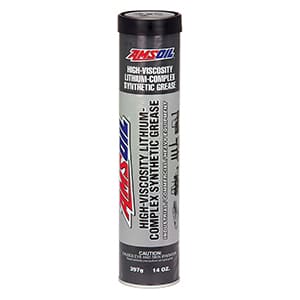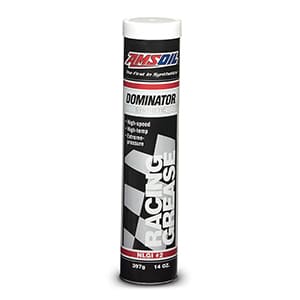Extreme pressure grease is intended for use in any area where there is severe pounding, shock loads, and extreme pressure. Some of these specific applications where extreme pressure grease is intended for would be ball joints, chassis points, fifth wheels, pins, universal joints, cam and slide mechanism, chains, bearings, bushings, etc.
Let’s discuss how a quality high performance extreme pressure grease is engineered.
Properties of an Extreme Pressure Grease
Grease is made up of 2 basic components, a thickening agent and a base oil. There are various combinations and types of thickeners and base oils that an oil company can formulate. In addition, there are various additives and modifiers, along with performance additives, that when blended together can give the grease unique lubricating characteristics.

When choosing the type of base oil that could be formulated into a grease, the list would show petroleum base oils, either paraffinic or naphthenic, or synthetic base oils such as esters, PAOs, glycols, and silicones. Like gear oils, hydraulic oils, engine oils, etc., deciding on the viscosity of the base fluid when manufacturing the grease would be the most important property.
For example, if choosing to engineer a high-temperature grease, then a higher viscosity, synthetic heavier base stock fluid would be chosen. If the goal is to formulate a grease that functions better for lower temperatures, then a synthetic base stock oil that is lighter and lower viscosity would be the best choice. Without a doubt, focusing your attention on only 100% synthetic base stock oils for an extreme pressure grease will deliver outstanding performance when the environment is extreme in terms of shock loads and extreme pressure.

The next component to consider when designing a lubricating grease would be the thickener. As the name implies, thickeners are added to base oils to give them a thicker or heavier structure. There are two common types of grease thickeners, and they are inorganic and organic. Organic thickeners come in the form of non-soap-based or soap-based. Inorganic thickeners come in a non-soap-based form.

The soap-based thickeners are created by a manufacturing process called saponification. The process involves combining an alkaline earth metal (alkali) with a vegetable or animal ester, or fatty acid. This combination is then reacted by either applying agitation, pressure, or heat. The fiber structure of this metal soap will determine the finished grease’s physical properties and mechanical stability.
When the goal is to create a grease with higher load carrying and high-temperature characteristics, it is then necessary to add what is called a complexing agent to the soap thickener. The result is what is called a soap-salt complex thickener. When constructing a grease with soap-salt complex thickeners, you end up with greases such as lithium-complex, calcium-sulfonate-complex, and calcium-lithium-complex greases. These complexes help to boost the performance characteristics of a grease.

To further improve a grease’s performance, lubrication chemists can blend in friction-reducing agents, anti-wear additives, and extreme pressure agents. The National Lubrication and Grease Institute (NLGI,) has created a grease classification that covers 9 grades of grease. These 9 grades are a follows: 000, 00, 0, 1, 2, 3, 4, 5, and 6. On the top end, which is NLGI #6, such greases are almost solid, and on the very low end, in this case, NLGI #000, these greases are almost fluid in consistency.

The higher NLGI grades are typically used in applications where sealing or leakage could be an issue, while the lower grades of the NLGI spectrum of grease are very often specified for use in lower temperature applications, where there will be better pumpability of the grease. NLGI #2 is the most common grease used in most applications.

How are these NLGI grades determined? A grease’s grade is measured utilizing the ASTM D217 test, known as the Cone Penetration Test. The test functions as follows. A standard cone is dropped into a specific grease for a duration of 5 seconds. Then the amount of penetration is measured in 1/10ths of a millimeter to determine its NLGI grade. The higher, or deeper, the penetration of the cone, the lower the NLGI number. For example, an NLGI #00 will show a cone penetration much deeper into the grease then say an NLGI #3 grease, which will have very little cone penetration due to its much thicker consistency.
What is an EP 2 Grease?
Now that we have established the basic structure of grease and how it is created, let’s discuss what an EP 2 grease is. First of all, EP stands for extreme pressure. 2 designates the grade, or consistency, of the grease. In other words, we are considering an NLGI #2 grease. As stated before, this grade grease is the most common used. There are many instances where extreme pressure (EP) grease can be used. An extreme pressure EP grease is important for equipment to keep metal surfaces from coming in contact with each other under shock loads and extreme pressure situations. It is the extreme pressure grease’s job to keep a protective barrier between these two metal surfaces.

When the goal is to create an extreme pressure capable grease, the lubrication chemists will add heavy-duty extreme pressure additives that are designed to absorb shock loads. Additionally, heavier oils, adhesive agents, and cohesive agents are added to make the grease resistance to squeezing out or pounding out. Also, a natural mineral molybdenum disulfide adds to a grease’s extreme pressure capabilities. An extreme pressure grease with 5% moly gives it extraordinary extreme pressure capabilities. 5% moly can withstand up to 500,000 psi, giving this extreme pressure grease an insurance policy against extraordinary shock loads and extreme pressure. For example, AMSOIL Synthetic Polymeric Off-Road Grease with 5% moly is the absolute finest when the subject of extreme pressure greases are being considered.

There are various specifications to look for that identify a grease as being an extreme pressure grease. The most common identifier when looking at a grease’s specifications is how it rates when tested during the Timken OK Load Test. This is a well-known extreme pressure test. If a grease score ranges between 75+ Timken OK Load, this grease is considered good for extreme pressure applications. Next, look at how the grease fared during the ASTM D226 4 Ball Wear Test. If the score was <0.45 mm scar diameter or less, this also shows that the grease is a good choice for extreme pressure applications.

Extreme Pressure Grease Is Intended For Maximum Protection in the Toughest Operating Conditions
Extreme pressure grease is intended for any vehicle or machinery that will be exposed to extreme shock loads and extreme pressures. For example, EP grease means the grease is an extreme pressure lubricant that is specified by the National Lubrication and Grease Institute (NLGI) to be a # 2-grade grease, the most common grade used in most industries.
